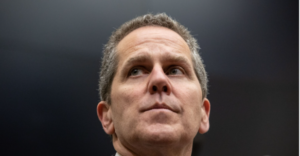
Michael Barrs Call to Action In the wake of the rapid growth of stablecoins, Michael Barr, a key figure in the Federal Reserve, has recently called for comprehensive regulation of these digital assets. This call comes as a response to the potential risks and uncertainties that stablecoins pose to the financial system. To understand the gravity of this call and its potential impact, we must first delve into the world of stablecoins and their current regulatory status.
Understanding Stablecoins
Stablecoins are a type of cryptocurrency designed to maintain a stable value, often by pegging their worth to traditional fiat currencies or other assets. Unlike traditional cryptocurrencies like Bitcoin, which can experience significant price fluctuations, stablecoins aim to provide a reliable medium of exchange and a store of value. Popular stablecoins include Tether (USDT), USD Coin (USDC), and DAI.
The Surge in Stablecoin Popularity
Stablecoins have gained significant traction in recent years due to their advantages. They enable fast and low-cost cross-border transactions, making them a popular choice for international remittances and e-commerce. Additionally, they provide a safe haven for cryptocurrency traders looking to mitigate market volatility.
The Lack of Regulation
One of the key factors contributing to the rise of stablecoins is their relative lack of regulation. Unlike traditional financial instruments, stablecoins operate in a regulatory gray area, which can lead to concerns related to investor protection, money laundering, and financial stability.
Michael Barr’s Call for Regulation
The Need for Oversight
Michael Barr, a respected voice in the financial sector, has raised concerns about the unregulated nature of stablecoins. He argues that the absence of clear regulatory frameworks exposes the financial system to potential risks. These risks include:
Systemic Risk: Unregulated stablecoins could become a systemic risk if they achieve widespread adoption and suddenly fail or lose their peg, potentially causing a financial crisis.
Money Laundering: The anonymity associated with some stablecoin transactions could facilitate money laundering activities, making it difficult for authorities to track illicit funds.
Consumer Protection: Investors and users of stablecoins may not have the same level of protection as traditional financial services offer.
Advantages of Regulation
By advocating for stablecoin regulation, Michael Barr aims to address these concerns while preserving the advantages that stablecoins bring to the financial industry. Regulation can:
Enhance Stability: Regulatory oversight can help stabilize the value and functioning of stablecoins, reducing the potential for market disruptions.
Increase Transparency: Regulation can mandate transparency and disclosure requirements, providing investors with more information about the stablecoin issuer’s assets and practices.
Prevent Illicit Activities: Regulation can establish Anti-Money Laundering (AML) and Know Your Customer (KYC) requirements, helping to deter and detect criminal activities.
The Implications of Stablecoin Regulation
Industry Impact
Stablecoin regulation could have a significant impact on various industry players. Exchanges that offer stablecoin trading would likely need to comply with new regulations. Stablecoin issuers may have to adhere to stringent reporting and compliance standards, which could affect their operational costs.
User Experience
From a user perspective, the implementation of stablecoin regulation may lead to increased security and trust in these digital assets. Users could have more confidence in the value stability of their holdings, knowing that regulatory safeguards are in place.
Financial System Stability
On a broader scale, stablecoin regulation could contribute to the stability of the entire financial system. By addressing potential systemic risks and enhancing oversight, regulators aim to prevent market disruptions and maintain confidence in the financial sector.
FAQs
How much does a SEO copywriter cost?
The cost of hiring an SEO copywriter can vary widely depending on factors such as the writer’s experience, the complexity of the project, and the length of the content. Freelance SEO copywriters may charge per word or per project, while agencies often have their pricing structures. It’s advisable to obtain quotes from multiple writers or agencies and consider the value they provide in terms of quality and SEO expertise.
Does a copywriter do SEO?
Yes, a copywriter can specialize in SEO, known as an SEO copywriter. These professionals are skilled in creating content that not only engages readers but also ranks well in search engine results. They use keyword research, on-page optimization techniques, and high-quality writing to improve a website’s visibility on search engines like Google.
What are SEO copywriting services?
SEO copywriting services involve creating content that is optimized for search engines. This includes researching and using relevant keywords, structuring content for readability and SEO, and adhering to best practices for on-page SEO. The goal is to attract organic traffic to a website by ensuring that its content ranks well in search engine results.
Which is better SEO or copywriting?
It’s not a matter of one being better than the other; they serve different purposes. SEO is about optimizing content to rank well in search engines, driving organic traffic. Copywriting focuses on creating persuasive and engaging content that resonates with the audience. For online success, a combination of both is often the most effective strategy, as high-quality content that also ranks well can bring in more traffic and convert visitors into customers.
Conclusion
In a financial world increasingly shaped by digital innovation, stablecoins have emerged as a game-changer, offering advantages in terms of efficiency and reliability. However, the lack of regulation has raised concerns about their long-term viability and potential risks. Federal Reserve Official Michael Barr’s call for stablecoin regulation highlights the need to strike a balance between innovation and oversight. While regulation may introduce new challenges, it also promises enhanced stability, transparency, and security for users and the broader financial system. As discussions surrounding stablecoin regulation continue, the financial industry remains at a critical juncture, with the potential to shape the future of digital finance.